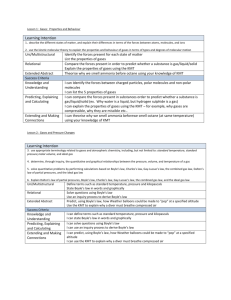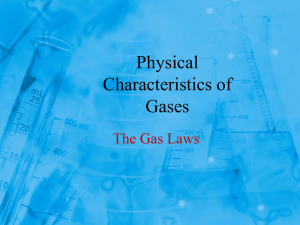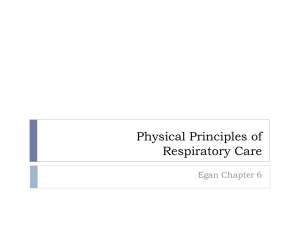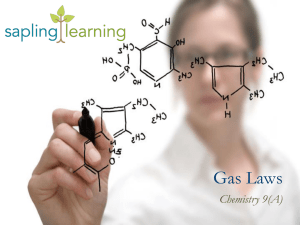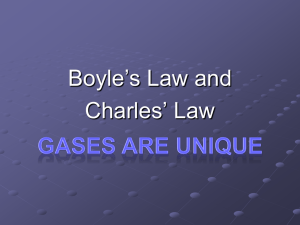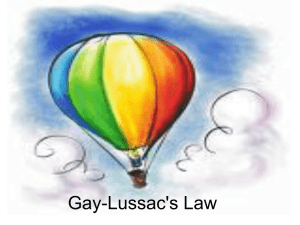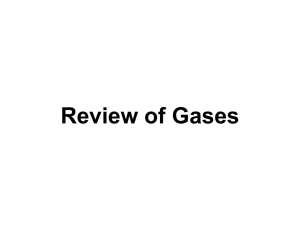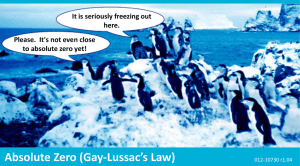Gases powerpoint - OISE-IS-Chemistry-2011-2012
advertisement
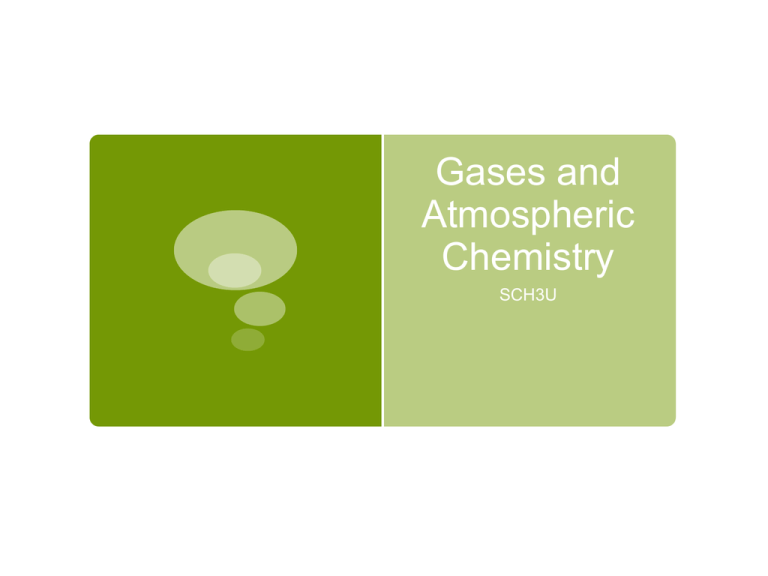
Gases and Atmospheric Chemistry SCH3U Lesson #1 Review of states of matter Introduction to Kinetic molecular theory postulates KMT outside Debrief Unit Mind Map Overview Why Study Gases? Why Study Gases? Everyday life: Medical technologies e.g. anesthetics Food industry e.g. gas in coke can Compose our atmosphere e.g. breathe oxygen and study of climate change Activities e.g. scuba diving, hot air balloons Pleasure e.g. air conditioning (compressed air that expands and gets cold) States of Matter States of Matter Solid: tightly packed together and vibrational movement Liquid: more loosely packed together but vibrational + rotational movement Gas: very spread apart with vibrational translational movement + rotational + Kinetic Molecular Theory A series of postulates that help explain how gases work (their properties, mechanisms and interactions) on a micro scale Kinetic Molecular Theory Gases consist of large numbers of tiny particles that are far apart relative to their own size. There are no forces of attraction or repulsion between gas particles. Gas particles move continuously, rapidly, and randomly in straight lines in all directions. All collisions between particles and each other or the container are considered to be elastic collisions (no loss of kinetic energy) The average kinetic energy depends on the temperature of the gas (directly increases with temperature increase) Human Kinetics! Rules: 1. Think of yourself as a small particle within a gas and the room is a Tupperware container that we are all in 2. Behave as the particle would according to the postulate being read 3. DO NOT loose kinetic energy, so no falling down or pushing each other around 4. Those who do not wish to participate can observe or act as a wall of the container 5. Any time you (as a particle) come in contact with another particle you must touch ping pong balls Lesson #2 Introduction to Boyle’s law Practice problems Introduction to Charles’ Law Practice problems GIZMO assignment Unit Mind Map Overview Gas laws Boyle’s Law Charles’ Law Gay-Lussac’s Law Dalton’s law of partial pressures Avogadro’s Law Ideal gas law Gas laws Boyle’s Law Charles’ Law Gay-Lussac’s Law Dalton’s law of partial pressures Avogadro’s Law Ideal gas law Boyle’s laws Relationship between volume and pressure What is this relationship? Boyle’s Law http://www.youtube.com/watch?v=XoytjcUmR90 Robert Boyle (1662) Boyle’s Law – As the volume of a gas increases, the pressure decreases as long as the temperature and amount of gas remain constant P1V1=P2V2 Boyle’s Law Slope of the line = k Pi x Vi = k Pf x Vf = k PiVi = PfVf Pressure Pressure what is it? Pressure Pressure force exerted on an object per unit of surface area: (Pressure =Force/Surface Area) (P = F/A ) Units of pressure Kilopascals (kPa) Standard atmospheric pressure at 0°C: 760mm Hg = 760 torr = 1atm = 101.3kPa STP (standard temperature and pressure) 0°C, 1atm How does a gas exert pressure? Sample problem using Boyle’s law Ammonia gas occupies a volume of 450mL at a pressure of 720mmHg. What volume will it occupy at standard pressure? *Boyle’s Law = P1V1 = P2V2 Complete p. 435 practice problems #3,4 Homework: p.435 section review # 4, 5, 6 Gas laws Boyle’s Law Charles’ Law Gay-Lussac’s Law Dalton’s law of partial pressures Avogadro’s Law Ideal gas law Gas laws Boyle’s Law Charles’ Law Gay-Lussac’s Law Dalton’s law of partial pressures Avogadro’s Law Ideal gas law Charles’ Law Relationship between volume and temperature What is this relationship? Charles’ Law http://www.youtube.com/watch?v=iSK5YlsMv4c&feature=related Jaques Charles Charles’ law the volume of a gas increases as the temperature increases as long as the mass and the pressure of the gas remain constant V1/T1 = V2/T2 Lungs cannot expand as much when it is cold Other examples? Kelvin Scale and Absolute Zero Kelvin Scale and Absolute Zero Lord Kelvin discovered that no matter what gas was tested, the temperature of any gas at a volume of 0 was always -273°C Kelvin Scale and Absolute Zero Molecular motion ceases at -273°C/0K New scale, where the starting point was zero (0K = 273°C) Standard temperature = 273K Must convert to K when solving: TK = °C + 273 Sample Problems Convert: A) 52°C to Kelvin B) 338K to °C A sample of argon gas is cooled and its volume went from 380mL to 250mL. If its final temperature was 55oC, what was its original temperature? Complete P. 446 practice problems #5 Homework P. 446 practice problems #6, 8, 11, 12 Lesson #3 Gay Lussac’s Law Dalton’s law Coke bottle activity/GIZMO Unit Mind Map Overview Gas laws Boyle’s Law Charles’ Law Gay-Lussac’s Law Dalton’s law of partial pressures Avogadro’s Law Ideal gas law Gas laws Boyle’s Law Charles’ Law Gay-Lussac’s Law Dalton’s law of partial pressures Avogadro’s Law Ideal gas law Gay-Lussac’s Law Most containers have a fixed volume but the temperature and pressure may vary Relationship? Gay-Lussac’s Law Gay-Lussac’s Law The pressure of a gas increases proportionally to the temperature as long as the volume remains constant (Pi/Ti) = (Pf/Tf) KMT Gay-Lussac’s Law Gay-Lussac’s Law The pressure or a gas increases proportionally to the temperature as long as the volume remains constant (Pi/Ti) = (Pf/Tf) KMT: temperature increases kinetic energy of molecules increase colliding with walls more often therefore pressure increases Gay-Lussac’s Law P1/T1 = 180kPa/100K = 1.8kPa/K P2/T2 = 360kPa/200K = 1.8kPa/K (P1/T1) = (P2/T2) Examples of Gay-Lussac’s Law Examples of Gay-Lussac’s Law Car tires in winter/summer? Heating up a bottle of soda? Why do aerosol cans have flammable sign? Sample Problems A sample of gas is stored in a reinforced steel container at -115°C, at a pressure of 39.9kPa. If the pressure was increased to 60kPa, what is the final Celsius temperature? Sample Problems A sample of gas is stored in a reinforced steel container at -115°C, at a pressure of 39.9kPa. If the pressure was increased to 60kPa, what is the final Celsius temperature? ANSWER: T2 = 241K, T2 = -32°C Sample Problems Soccer balls are typically inflated between 60 and 110kPa. A soccer ball is inflated indoors with a pressure of 85kPa at 25°C. If it is taken outside, where the temperature on the playing field is -11.4°C, what is the pressure of the gas inside the soccer ball? Sample Problems Soccer balls are typically inflated between 60 and 110kPa. A soccer ball is inflated indoors with a pressure of 85kPa at 25°C. If it is taken outside, where the temperature on the playing field is -11.4°C, what is the pressure of the gas inside the soccer ball? Answer: 96.6 kPa HOMEWORK: p. 450 #14, 15 p. 451 #2, 3, 4, 5 Gas laws Boyle’s Law Charles’ Law Gay-Lussac’s Law Dalton’s law of partial pressures Avogadro’s Law Ideal gas law Gas laws Boyle’s Law Charles’ Law Gay-Lussac’s Law Dalton’s law of partial pressures Avogadro’s Law Ideal gas law The Atmosphere Gases in the atmosphere? The Atmosphere The atmosphere consists of many gases, what are they? 78.08% Nitrogen 20.95% Oxygen 0.93% Argon 0.03% Carbon Dioxide 0.002% Neon 0.008% other gases Mixture of Gases Mixture of Gases The atmosphere – air Volcanic eruptions expansion of a mixture of gases Anesthesiology Natural gas mixture of hydrocarbon gases Dalton’s Law of Partial Pressures Partial pressures force exerted by one gas in a mixture of gases Law of partial pressures the total pressure of a mixture of non-reacting gases is equal to the sum of partial pressures of the individual gases Ptotal = P1 + P2 + P3 + P4 … Kinetic Molecular Theory? Sample Problem The pressure of a mixture of nitrogen, carbon dioxide, and oxygen is 150 kPa. What is the partial pressure of oxygen if the partial pressures of the nitrogen and carbon dioxide are 100 kPA and 24 kPa, respectively? Sample Problem The pressure of a mixture of nitrogen, carbon dioxide, and oxygen is 150 kPa. What is the partial pressure of oxygen if the partial pressures of the nitrogen and carbon dioxide are 100 kPA and 24 kPa, respectively? Answer: 26kPa Sample Problem What is the pressure contribution of Nitrogen on a very dry day when the barometer read 0.98atm? Components Percentage Nitrogen 79% Oxygen 21% Argon 1% Carbon Dioxide 0.03% Other gases 0.008% Sample Problem What is the pressure contribution of Nitrogen on a very dry day when the barometer read 0.98atm? Solution: %N 2 ´ 100 Total Atmospheric pressure = (79%/100) x 0.98atm = 0.77atm Components Percentage Nitrogen 79% Oxygen 21% Argon 1% Carbon Dioxide 0.03% Other gases 0.008% Sample Problem HOMEWORK: #22, 23, 24 Lesson #4 Avogadro’s principle Ideal gas law Coke bottle activity/GIZMO Unit Mind Map Overview Gas laws Boyle’s Law Charles’ Law Gay-Lussac’s Law Dalton’s law of partial pressures Avogadro’s Law Ideal gas law Gas laws Boyle’s Law Charles’ Law Gay-Lussac’s Law Dalton’s law of partial pressures Avogadro’s Law Ideal gas law Avogadro What do you think of when you hear “Avogadro”? Avogadro What do you think of when you hear “Avogadro”? Avogadro’s Law Avogadro’s Law: equal volumes of gases at the same temperature and pressure contain equal number of moles Avogadro’s Law Avogadro’s Law: equal volumes of gases at the same temperature and pressure contain equal number of moles V1 = V2 n1 n2 Sample problem A balloon with a volume of 34.5L is filled with 3.2mol of helium gas. To what volume will the balloon expand if another 8.0g of helium is added? (Assume that pressure and temperature do not change) Sample problem A balloon with a volume of 34.5L is filled with 3.2mol of helium gas. To what volume will the balloon expand if another 8.0g of helium is added? (Assume that pressure and temperature do not change) ANSWER: 20.9L Molar Volume Molar volume: the volume that 1 mol of ANY GAS occupies at STP (273K, 1atm) Molar volume = 22.4L/mol Note whether the conditions are in STP Sample problem You are at a farm in the country side collecting samples of methane from cows. At STP, how many moles of are found in 2.5L of methane (CH4)? Sample problem You are at a farm in the country side collecting samples of methane from cows. At STP, how many moles of are found in 2.5L of methane (CH4)? ANSWER: 0.11mol Sample problem Calculate the volume that 4.5kg of ethylene gas (C2H4) will occupy at STP. Sample problem Calculate the volume that 4.5kg of ethylene gas (C2H4) will occupy at STP. ANSWER: 3,548L HOMEWORK: Practice problems p. 477 #14 Practice problems p. 482 # 5, 8, 9 Gas laws Boyle’s Law Charles’ Law Gay-Lussac’s Law Dalton’s law of partial pressures Avogadro’s Law Ideal gas law Gas laws Boyle’s Law Charles’ Law Gay-Lussac’s Law Dalton’s law of partial pressures Avogadro’s Law Ideal gas law Ideal Gas Law Ideal Gas Law Kinetic molecular theory explains what an “ideal gas” is “Ideal” versus “Real” gas Ideal Gas Law: R constant R constant: 1atm ´ 22.4L = 0.0821 273K 101.3kPa ´ 22.4L = 8.314 273K 760mmHg ´ 22.4L = 62.4 273K Ideal Gas Law Ideal Gas Law: Sample Problem What is the pressure in atm of a 0.108mol sample of He gas at a temperature of 20°C if its volume is 0.505L? (R = 0.0821atm*L*K-1 or R = 8.314kPa*L*K-1 or R = 62.4mmHg*L*K-1) Sample Problem What is the pressure in atm of a 0.108mol sample of He gas at a temperature of 20°C if its volume is 0.505L? ANSWER: 5.14atm Sample Problem Dentists sometimes use laughing gas (N2O) to keep patients relaxed during dental procedures. If I have 2.4 moles of laughing gas in a 45L container at 97°C, what is the pressure in kPa? (R = 0.0821atm*L*K-1 or R = 8.314kPa*L*K-1 or R = 62.4mmHg*L*K-1) Sample Problem Dentists sometimes use laughing gas (N2O) to keep patients relaxed during dental procedures. If I have 2.4 moles of laughing gas in a 45L container at 97°C, what is the pressure in kPa? ANSWER: 164.1kPa HOMEWORK: Practice problems p. 488 #1, 3, 4, 5, 6
